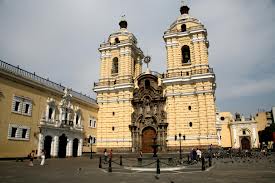 Our adventure began in the capital of Peru, Lima. After a 6:00 a.m. arrival at our hotel and a long nap, a guided city tour of the historic capital awaited us and fellow Gate-One travelers. The highlight of the tour was the Convento de San Francisco, a Moorish style colonial-era church with underground catacombs. One of my favorite rooms was the library, with old yellowing books lining the walls from floor to ceiling, falling apart and turning to dust in the musky forgotten time-capsule. Mostly written in Latin, it was paradise for a colonial-era researcher whom could read the nearly dead language. I’d secretly hoped someone would transcribe and preserve the important documents the library held. Natural light beaming from skylights and windows, along with humidity and time, would destroy books holding crucial information by the end of this century. Two enormous music books the size of a standard suitcase were the focal point of the room. We later learned these were exhibited on a thick rotating cedar music stand for the entire choir to view during mass, while a boy stood turning the page.
Our adventure began in the capital of Peru, Lima. After a 6:00 a.m. arrival at our hotel and a long nap, a guided city tour of the historic capital awaited us and fellow Gate-One travelers. The highlight of the tour was the Convento de San Francisco, a Moorish style colonial-era church with underground catacombs. One of my favorite rooms was the library, with old yellowing books lining the walls from floor to ceiling, falling apart and turning to dust in the musky forgotten time-capsule. Mostly written in Latin, it was paradise for a colonial-era researcher whom could read the nearly dead language. I’d secretly hoped someone would transcribe and preserve the important documents the library held. Natural light beaming from skylights and windows, along with humidity and time, would destroy books holding crucial information by the end of this century. Two enormous music books the size of a standard suitcase were the focal point of the room. We later learned these were exhibited on a thick rotating cedar music stand for the entire choir to view during mass, while a boy stood turning the page.
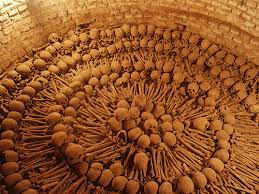 The catacombs took us deeper into the belly of the cathedral. As we followed groups of tourists, my thoughts drifted towards earthquakes and how Lima had many great shattering quakes through time. “It’s the last and worst place I’d want to be during an earthquake,” I whispered to my husband, lingering towards the end of the line. I needed plenty of room in case of an emergency. An extra benefit of this tactic was exploring rooms others mindlessly passed. We peered into a large circular well filled with hundreds of skulls, a scene straight from Indiana Jones, and The Temple of Doom. My eyes widened as hubby urged me to take a picture since nobody was looking.
The catacombs took us deeper into the belly of the cathedral. As we followed groups of tourists, my thoughts drifted towards earthquakes and how Lima had many great shattering quakes through time. “It’s the last and worst place I’d want to be during an earthquake,” I whispered to my husband, lingering towards the end of the line. I needed plenty of room in case of an emergency. An extra benefit of this tactic was exploring rooms others mindlessly passed. We peered into a large circular well filled with hundreds of skulls, a scene straight from Indiana Jones, and The Temple of Doom. My eyes widened as hubby urged me to take a picture since nobody was looking.
“No, I obey the rules as an archaeologist.” I shot him a sideways look, “Besides, I don’t want any bad Ju Ju.”
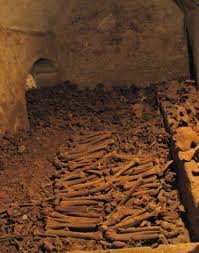 Catching up with others passing rectangular ditches overflowing with large bones, mostly femurs interspersed with hip bones and skulls, I noticed many people covering their nose. It was dank, but not too different from the library. Perhaps the sight of numerous human skeletal remains automatically caused some to cover their nose and face, sheltering the possibly contaminated repulsive air they breathed. I shrugged worrying more about an earthquake burying me alive.
Catching up with others passing rectangular ditches overflowing with large bones, mostly femurs interspersed with hip bones and skulls, I noticed many people covering their nose. It was dank, but not too different from the library. Perhaps the sight of numerous human skeletal remains automatically caused some to cover their nose and face, sheltering the possibly contaminated repulsive air they breathed. I shrugged worrying more about an earthquake burying me alive.
The next morning we had a quick flight to Cuzco and longer bus ride to the sacred valley, the heartland of the Inca. Exactly twenty years ago I’d visited this region and fell in love with the otherworldly scenery holding snow-capped mountains, winding roads, idyllic villages and green valleys filled with corn, potatoes and quinoa, all of which ended up in our home-cooked lunch.
“They work the land without tractors,” our guide gloated through the microphone.” You will not find more than ten tractors in this area,” he challenged. “If you do, then I’ll buy everyone a Pisco Sour. Humm,” he added with is usual filler at the end of a sentence. Not knowing how determined and thirsty his Canadian and American tourists were, our group spotted more than ten questionable tractors on our way to the Urubamba Valley and the Ollantaytambo ruins near our five-star hotel in the middle of nowhere. Over the next few days ten more tractors would be found for another Pisco Sour, the local cocktail.
The sacred Ollantaytambo ruins were farming terraces for the Inca gods, cyclopean in every aspect coinciding with the stars rising and setting during important harvest times. We separated, exploring on our own, meeting back at the bus for a brief ride to our living quarters for the next two nights. Surrounded by the Andes in every direction, the views were spectacular. An unusual hail storm welcomed us during check-in, with frozen white pellets the size of M&M’s falling from the skies and the Inca gods above. “Priceless,” I whispered to the heavens, admiring the lightning storm in the encompassing mountains.
The following morning I went for a challenging jog up the stone Inca village streets. Unruffled dogs ruled the streets, sharing with donkeys, pigs, llamas, and kids walking miles to school, smiling while passing a crazy running blonde gringo. I was at 9,000 feet hiking uphill, jogging on flat areas and downhill. With the sun rising at 5:00 a.m., it was already warming up by 7:00.
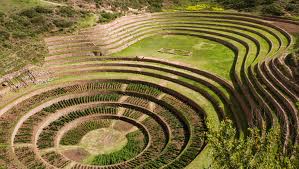 The bus took us on an optional tour to the surreal salt pans of Maras, then to the unique archaeological site, Moray, the highlight of my day. Historical in magnitude, this Inca site was a testing area for crops, reflecting the importance of farming to the Incas. At a single location they experimented with a variety of produce at different temperatures using a terrace system utilizing microclimates within the empire. With this approach they were able to test vegetables in different environments, pushing evolution of corn, potatoes and other plants for maximum productivity. I marveled at their technique and clever invention. Then I went back to the lodge for a massage and relaxing evening prior to our busy following day at Machu Picchu,the star of the Urubamba Valley and the Inca Empire.
The bus took us on an optional tour to the surreal salt pans of Maras, then to the unique archaeological site, Moray, the highlight of my day. Historical in magnitude, this Inca site was a testing area for crops, reflecting the importance of farming to the Incas. At a single location they experimented with a variety of produce at different temperatures using a terrace system utilizing microclimates within the empire. With this approach they were able to test vegetables in different environments, pushing evolution of corn, potatoes and other plants for maximum productivity. I marveled at their technique and clever invention. Then I went back to the lodge for a massage and relaxing evening prior to our busy following day at Machu Picchu,the star of the Urubamba Valley and the Inca Empire.
Our group caught the early morning train on the fairly new Vistadome train to Machu Picchu. It was first class travel with transcendent views of the towering Andes mountains leading up to one of the seven wonders of the new world. We were dumped into a tourist town that didn’t exist twenty years ago. Merchants, restaurants,and enormous lines awaited us. I was flabbergasted from the growth of tourism such a forgotten empire attracted. I took a breath realizing the world was now aware of the beauty of Machu Picchu, and it was not such a bad thing as long as respect for the site ensued. Why should I be the only one to experience such beauty? I was certainly glad I saw it in my youth, prior to the crowds, permits and limitations to visit the lesser known Huana Picchu, now a three-day or more wait. The line moved quickly and we were on our way via bus along the winding road to the most popular archaeological site in South America. My hands sweated at the cliffs we traversed in the speeding van, as it did twenty years prior.
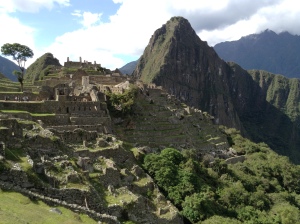 One thing about Machu Picchu, you could never visit too much. Always spectacular with something new to discover. I approached with new eyes and no expectations, realizing it deserved recognition as one of the seven wonders of the new world. With only a few hours to visit and feeling relieved that I’d visited before, the pressure was off to see everything within a few hours. No studying or analyzing with an archaeological mind, just unbiased observation. I listened to our guide while exploring the less visited areas such as the Inca bridge. I took pictures from all angles including the spot of Hiram Bingham’s most popular photograph for National Geographic. The truth is any and all pictures of the site are sublime because the location itself is photogenic, yet pictures don’t do it justice. Even a panoramic could not capture what it’s like to experience Machu Picchu. Perhaps that’s why it’s one of the wonder’s of the world.
One thing about Machu Picchu, you could never visit too much. Always spectacular with something new to discover. I approached with new eyes and no expectations, realizing it deserved recognition as one of the seven wonders of the new world. With only a few hours to visit and feeling relieved that I’d visited before, the pressure was off to see everything within a few hours. No studying or analyzing with an archaeological mind, just unbiased observation. I listened to our guide while exploring the less visited areas such as the Inca bridge. I took pictures from all angles including the spot of Hiram Bingham’s most popular photograph for National Geographic. The truth is any and all pictures of the site are sublime because the location itself is photogenic, yet pictures don’t do it justice. Even a panoramic could not capture what it’s like to experience Machu Picchu. Perhaps that’s why it’s one of the wonder’s of the world.
It has hit the ranks of mass tourism, yet it’s something to see outside of pictures or documentaries. A perfect end to the day with a beer and pizza after a rewarding hike among the giant civilizations of the new world.
We continued our journey to Cuzco and Lake Titicaca which I’ll continue next week in another blog covering Peru and the Inca Empire.
I love all of your pictures and your take on seeing such a famous Wonder. I haven’t been there yet, but I’ve heard it is even more incredible to see and experience in person. It makes me think about what will be left of our civilization as it is now in the centuries to come.
Thanks Kara. I think it’s a must see and do experience.